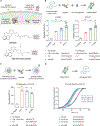A covalent inhibitor of K-Ras(G12C) induces MHC class I presentation of haptenated peptide neoepitopes targetable by immunotherapy
- PMID: 36099883
- PMCID: PMC10393267
- DOI: 10.1016/j.ccell.2022.07.005
A covalent inhibitor of K-Ras(G12C) induces MHC class I presentation of haptenated peptide neoepitopes targetable by immunotherapy
Abstract
Immunotargeting of tumor-specific antigens is a powerful therapeutic strategy. Immunotherapies directed at MHC-I complexes have expanded the scope of antigens and enabled the direct targeting of intracellular oncoproteins at the cell surface. We asked whether covalent drugs that alkylate mutated residues on oncoproteins could act as haptens to generate unique MHC-I-restricted neoantigens. Here, we report that KRAS G12C mutant cells treated with the covalent inhibitor ARS1620 present ARS1620-modified peptides in MHC-I complexes. Using ARS1620-specific antibodies identified by phage display, we show that these haptenated MHC-I complexes can serve as tumor-specific neoantigens and that a bispecific T cell engager construct based on a hapten-specific antibody elicits a cytotoxic T cell response against KRAS G12C cells, including those resistant to direct KRAS G12C inhibition. With multiple K-RAS G12C inhibitors in clinical use or undergoing clinical trials, our results present a strategy to enhance their efficacy and overcome the rapidly arising tumor resistance.
Keywords: ARS1620; KRas; MHC-I; antibody; cancer; covalent inhibitors; drug resistance; immunotherapy.
Copyright © 2022 The Authors. Published by Elsevier Inc. All rights reserved.
Conflict of interest statement
Declaration of interests C.S.C., K.S.M., Z.Z., and P.J.R. are inventors on a provisional patent application covering this work and owned by the University of California, San Francisco (UCSF). K.M.S. is an inventor on patent applications related to this technology owned by UCSF. K.M.S. is an inventor on patents covering covalent inhibitors of K-Ras(G12C) owned by UCSF and licensed to Wellspring Biosciences. K.M.S. is a consultant to and shareholder in the following companies: Revolution Medicines, Black Diamond Therapeutics, BridGene Biosciences, Denali Therapeutics, Dice Molecules, eFFECTOR Therapeutics, Erasca, Genentech/Roche, Janssen Pharmaceuticals, Kumquat Biosciences, Kura Oncology, Mitokinin, Nested, Type6 Therapeutics, Venthera, Wellspring Biosciences (Araxes Pharma), Nextech, Radd, Totus, Vicinitas, Turning Point, Ikena, Initial Therapeutics, Vevo, and BioTheryX.
Figures




Comment in
-
Getting a handle on KRAS inhibitor resistance with hapten-mediated anti-tumor immunity.Cancer Cell. 2022 Sep 12;40(9):908-910. doi: 10.1016/j.ccell.2022.08.018. Cancer Cell. 2022. PMID: 36099887
-
Bispecific T cell engagers kill resistant cells during KRAS-G12C blockade therapy.Oncoimmunology. 2022 Nov 1;11(1):2141978. doi: 10.1080/2162402X.2022.2141978. eCollection 2022. Oncoimmunology. 2022. PMID: 36338145 Free PMC article.
References
-
- Adams PD, Afonine PV, Bunkóczi G, Chen VB, Davis IW, Echols N, Headd JJ, Hung L-W, Kapral GJ, Grosse-Kunstleve RW, et al. (2010). {\it PHENIX}: a comprehensive Python-based system for macromolecular structure solution. Acta Crystallographica Section D 66, 213–221. 10.1107/S0907444909052925. - DOI - PMC - PubMed
-
- Chang AY., Dao T., Gejman RS., Jarvis CA., Scott A., Dubrovsky L., Mathias MD., Korontsvit T., Zakhaleva V., Curcio M., et al.. (2017). A therapeutic T cell receptor mimic antibody targets tumor-associated PRAME peptide/HLA-I antigens. J Clin Invest 127, 2705–2718. 10.1172/JCI92335. - DOI - PMC - PubMed
MeSH terms
Substances
Grants and funding
LinkOut - more resources
Full Text Sources
Other Literature Sources
Medical
Molecular Biology Databases
Research Materials
Miscellaneous

